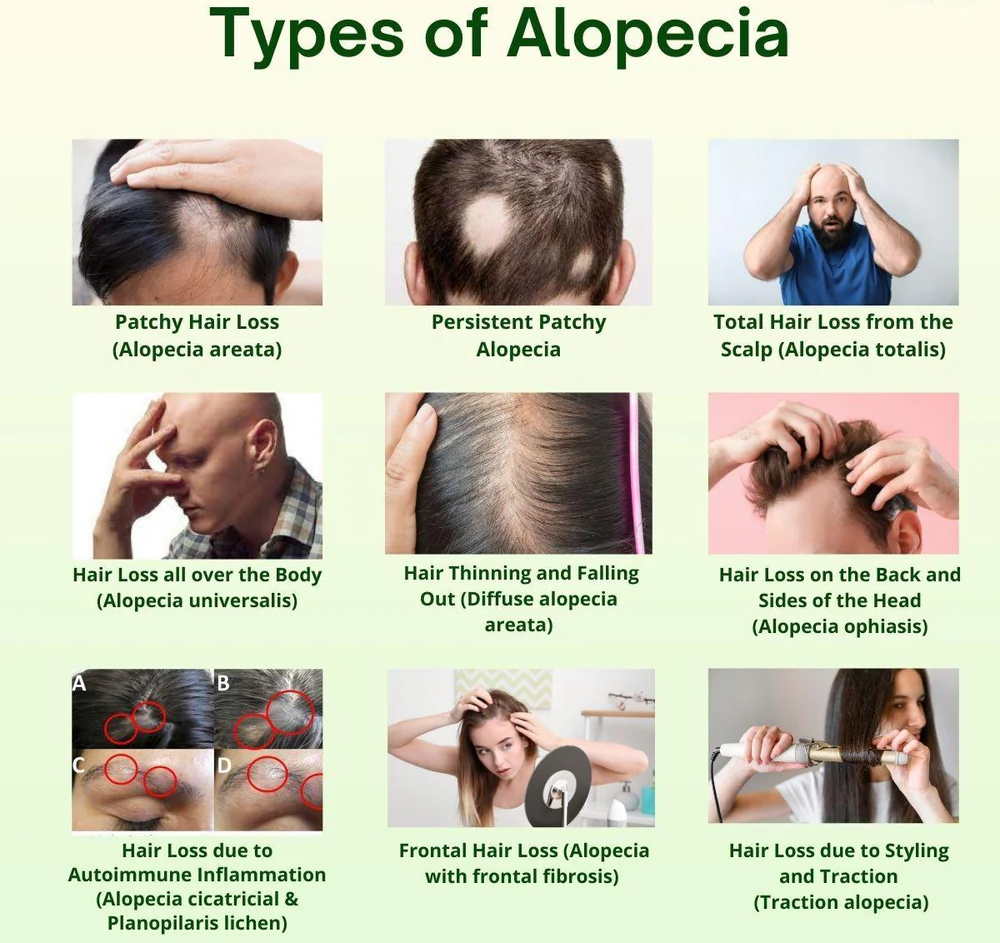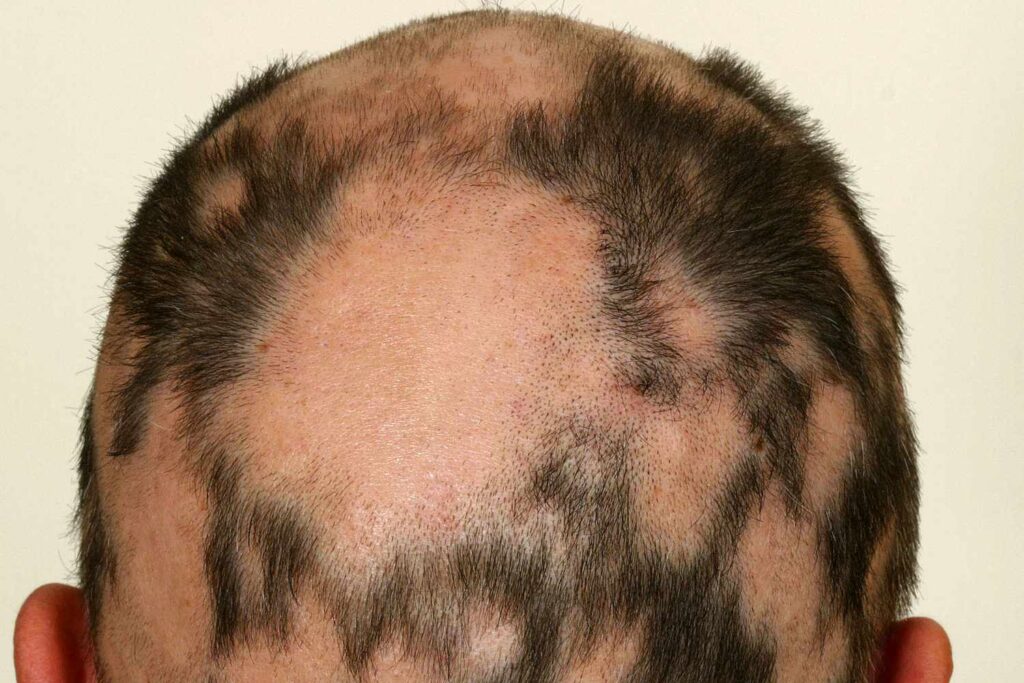What is Alopecia?
Alopecia is the medical term for hair loss, which can occur naturally or due to diseases and certain medications. The symptoms of alopecia vary based on the cause and can range from small bald patches to complete loss of all body hair.
Types of Alopecia
1. Male-Pattern Baldness
- Prevalence: Affects around 50% of men by age 50.
- Cause: Hereditary, associated with excess hormones affecting hair follicles.
- Symptoms: Receding hairline and thinning hair, typically beginning in the late 20s or early 30s.
2. Female-Pattern Baldness
- Prevalence: Common in post-menopausal women.
- Cause: Unclear, but may be linked to hormonal changes.
- Symptoms: General thinning of hair, rather than distinct patches.
3. Alopecia Areata
- Prevalence: Can affect men, women, and children, most commonly teenagers and young adults.
- Cause: Autoimmune disorder; often hereditary.
- Symptoms: Sudden bald patches that may resolve and recur, usually on the scalp.
4. Scarring Alopecia (Cicatricial Alopecia)
- Prevalence: Affects about 7% of alopecia cases.
- Cause: Rare conditions like scleroderma and discoid lupus that destroy hair follicles.
- Symptoms: Permanent hair loss.
5. Anagen Effluvium
- Prevalence: Commonly occurs due to cancer treatments.
- Cause: Chemotherapy, radiotherapy, or immunotherapy.
- Symptoms: Rapid hair loss from the scalp, face, and body, typically temporary.
6. Telogen Effluvium
- Prevalence: Often triggered by stress or physical shock.
- Cause: Stress, hormonal changes, chronic diseases, dietary changes, infections, certain medications.
- Symptoms: General thinning of hair, with temporary hair loss.

Understanding How Alopecia Areata Works
Alopecia areata occurs when the immune system mistakenly attacks the body’s hair follicles, similar to how it combats germs and viruses. This results in the hair falling out and halting growth. Other signs and symptoms may include:
- Changes in fingernails, such as dents, white spots, roughness, thinning, and splitting.
- Itching or minor discomfort on the skin where hair loss is imminent or has occurred.
- Sinus discomfort or eye irritation if eyebrows and eyelashes are lost.
Symptoms of Alopecia
- Hair Loss: Typically occurs in small, round patches on the scalp, which can progress to total baldness (alopecia totalis) or complete loss of body hair (alopecia universalis).
- Patchy Bald Spots: Smooth, round bald spots on the scalp, usually coin-sized initially but can enlarge over time.
- Gradual Thinning: Some people may experience a gradual thinning of hair rather than distinct bald patches.
- Changes in Nail Appearance: Nails may become pitted or ridged in some cases of alopecia areata.
- Sudden Hair Loss: Hair loss can occur suddenly and may be noticeable during periods of stress or illness.
- Regrowth: Hair may grow back in one area while another bald patch develops elsewhere.
- Itching or Discomfort: Mild itching or discomfort in the affected areas.
- Emotional Impact: Significant psychological effects, leading to anxiety, depression, or low self-esteem.
How a Dermatologist Diagnoses Alopecia Areata
Hair loss can have various causes, but if alopecia areata is suspected, a board-certified dermatologist can diagnose it by examining the affected skin areas. Diagnosis may involve:
- Removing a few hairs or performing a biopsy of the bald area, which involves examining a sample of the affected skin under a microscope.
- Using a dermatoscope to closely examine the scalp.
- Conducting blood tests to help diagnose alopecia areata and other immune system-related diseases.
Risk Factors for Alopecia
- Genetics: Family history plays a significant role, as alopecia often runs in families.
- Autoimmune Conditions: Disorders like rheumatoid arthritis, lupus, or thyroid diseases increase susceptibility.
- Age: Alopecia areata often begins in childhood or early adulthood, while male and female pattern baldness typically develops with age.
- Hormonal Changes: Imbalances during pregnancy, childbirth, or menopause can trigger hair loss.
- Medical Treatments: Chemotherapy and radiation therapy used in cancer treatment commonly lead to hair loss.
- Stress: Emotional or physical stress can contribute to temporary hair loss.
- Hair Practices: Excessive hairstyling (e.g., tight ponytails, braids) or treatments (e.g., frequent dyeing, heat styling) can damage hair follicles.
- Nutritional Deficiencies: Inadequate intake of certain nutrients, like iron or protein, may affect hair health.
- Environmental Factors: Exposure to pollutants or toxins can impact hair growth.
- Medications: Certain drugs used for arthritis, depression, heart problems, etc., list hair loss as a potential side effect.
Treatment Options for Alopecia
Medications:
- Minoxidil: An over-the-counter treatment that stimulates hair growth.
- Finasteride: A prescription medication that blocks DHT, effective for male-pattern baldness.
- Corticosteroids: Medications that reduce inflammation and suppress the immune response causing hair loss.
Topical Treatments:
- Anthralin: Alters immune function in the skin to promote hair growth.
- Topical Immunotherapy: Chemicals applied to the scalp to induce an allergic reaction, stimulating hair growth.
Light Therapy:
- Phototherapy: Exposure to ultraviolet light to treat scalp inflammation.
Surgical Options:
- Hair Transplant: Moving hair follicles from areas of thick hair to bald areas.
- Scalp Reduction: A surgical procedure that removes bald scalp and stretches hair-covered scalp over the area.
Lifestyle Changes:
- Stress Management: Reducing stress may help prevent or manage episodes of hair loss.
- Nutritional Supplements: Ensuring adequate intake of essential vitamins and minerals for hair growth.
Alternative Therapies:
- Aromatherapy: Essential oils like lavender or rosemary may promote hair growth.
- Acupuncture: Some studies suggest it may improve blood circulation to the scalp.
Supportive Therapies:
- Counseling: Addressing the emotional impact of hair loss.
- Wigs or Hairpieces: Cosmetic options to cover baldness.
These treatments vary in effectiveness depending on the type and severity of alopecia. Consulting with a dermatologist or healthcare provider is crucial to determine the most suitable treatment plan.
Self-Care Tips for Managing Alopecia
Hair Care
- Gentle Brushing: Use a soft-bristled brush or wide-toothed comb to minimize hair tugging.
- Regular Shampooing: Keep washing your hair to prevent dandruff and other scalp issues.
- Avoid Heat: Use a hair dryer on medium heat or lower and avoid hot rollers or irons.
Sun Protection
- Sunscreen: Apply gel-based sunscreen to bald patches with at least SPF 30.
- Hats: Wear solid woven hats with a wide brim to protect your scalp, ears, nose, and neck.
Cold Protection
- Warm Clothing: Wear hats in colder weather and consider sleeping caps for nighttime warmth.
Adjusting to Other Hair Loss
- Eyebrows: Wear a hat, headband, or bandana to protect your eyes.
- Eyelashes: Use glasses or sunglasses to shield your eyes and eye drops to reduce irritation.
- Nose Hair: Use a humidifier to add moisture and consider wearing a mask to filter air.

Managing Stress
- Sudden hair loss from alopecia areata can be highly stressful, which negatively affects your immune system and makes recovery from flare-ups harder. Managing stress is crucial for both your quality of life and coping with the disease. Effective stress relief methods include:
- Meditation
- Hiking in a park
- Listening to music
- Talking with a trusted friend, family member, counselor, or medical professional
Conclusion
While alopecia doesn’t cause physical pain or illness, its psychological impact can be significant. Managing alopecia with proper hair care, sun and cold protection, and stress management can improve quality of life. For persistent or severe cases, consult a healthcare provider for personalized treatment options.
